equine anatomy exam 1
1/218
Earn XP
Description and Tags
adsc 4230
Name | Mastery | Learn | Test | Matching | Spaced |
|---|
No study sessions yet.
219 Terms
Dorsal
Towards back or withers
Ventral
Towards belly or underside
Cranial
Towards the head
Caudal
Towards the tail
Anterior
Towards the head
Posterior
Towards the tail
Medial
Towards the inside of the body
Lateral
Towards the outside of the body
Ipsilateral
Referring to structures on the same side of the body
Contralateral
Referring to structures on opposite sides of the body
Superficial
Referring to structures closer to the surface of the body
Deep
Referring to structures farther from the surface of the body
External
Referring to structures located on the outer side of the body or away from center
Internal
Referring to structures located within the body or closer to the center
Adaxial
Referring to structures that are closer to the midline or axis of the body
Abaxial
Referring to structures that are farther from the midline or axis of the body
Palmar
Towards the back of the front leg
Plantar
Towards the back if the hind leg
What is anatomy?
Structure of the horse
What does anatomy determine?
how the horse looks
how the horse will move
what the horse will be able to do
how the horse will be throughout its life
How many bones in a horse?
206
Purpose of the skeleton
to protect vital organs of the horse
to provide structural framework for muscles, tendons, etc.
Purpose of bones
serve as levers
store minerals
sites of red blood cell formation
should NOT be in contact
long bones
found in horses’ limbs
aid in locomotion, mineral storage
act as levels
short bones
found in the joints
absorb concussion, allow joints to bend upon impact
flat bones
protect vital organs by enclosing body cavities
irregular bones
vertebrae of horse, protect CNS
example of long bones
cannon bone, femur, etc.
example of short bones
knee (carpus)
example of flat bones
ribs
example of irregular bones
spinal column
How do bones change?
they are constantly remodeling due to stress, based on concussion
Structure of bone
Not hollow, yet not solid
Articular cartilage
located at the ends of bones where they meet to form joints
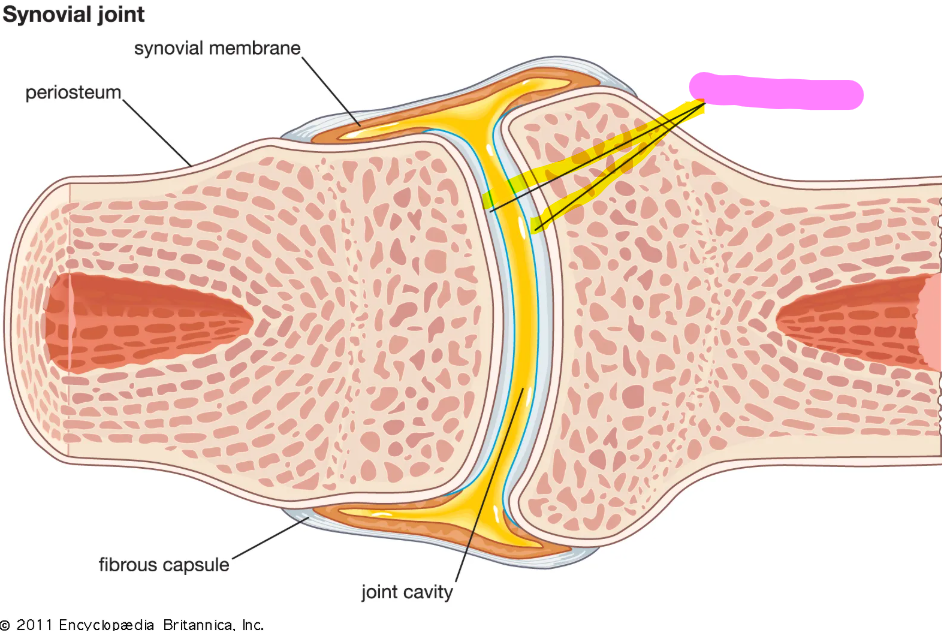
Cancellous (spongy) bone
Found in the broad ends of long bones
Cortical bone
Dense part of the bone, able to withstand impact
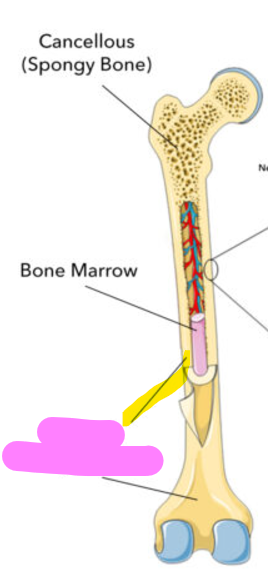
Periosteum
Touch outer cover around bone

Epiphysis
Ends of bones
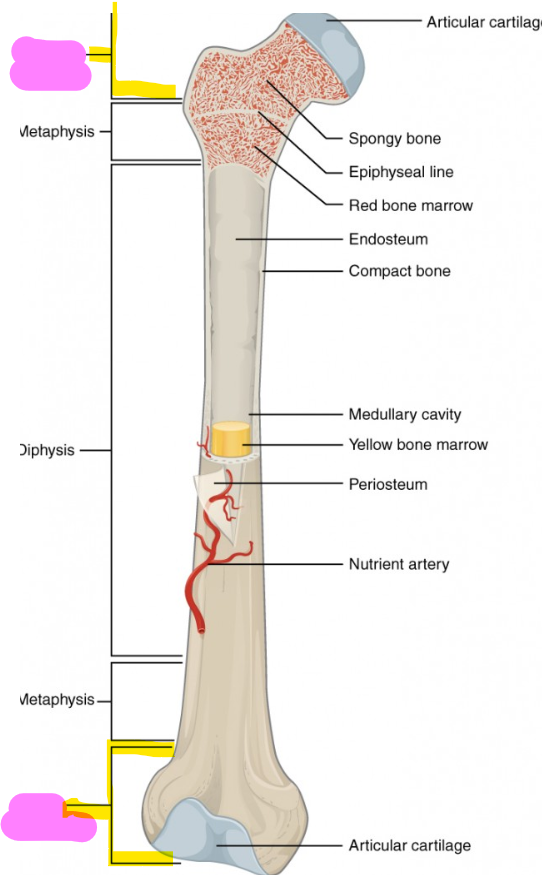
What are joints?
The connection between bones
Arthritis
Narrowing of joint space with a decrease in synovial fluid; damage to cartilage as it comes into contact as the joint moves
Developmental orthopedic disease
Joint issue, common in young horses and occurs when bone does not form properly at birth
What types of activities predispose horses to joint disease?
high impact + repetitive motions such as jumping (extends joints)
Hyaluronic Acid joint injections
Down regulates inflammation can improve joint structure
Why is arthritis hard to treat?
Cartilage takes a while to turn over, some medicines can speed this process up but not by much
What is soft tissue in the horse?
Primarily ligaments and tendons, some muscle
Tendons
Bind muscle to bone; NO contractile properties
Ligaments
Bind bone to bone; NO contractile properties
Why are soft tissue injuries so hard to rehab in horses?
Tendons are ligament injuries frequently recur even if initial injury heals because they typically grow back not as elastic
How is collagen typically laid down to repair soft tissue injuries?
Type-3 (weaker) fills void much quicker than type-1 collagen which is much stronger due to crosslinks
What is elastic modulus in regards to soft tissue?
Amount you can deform soft tissue and have it still return to shape
How do muscles create movement?
Contractile proteins stacked in the muscle slide + shorten
In what way do muscles resist movement?
They counteract the body weight of the horse
How did leg structure of horses change with evolution?
Leg structure changed from splay foot for support to harder single toe
What is the splint bone?
Remnant toe
Unguligrade
Hoof walking; example: deer, horse
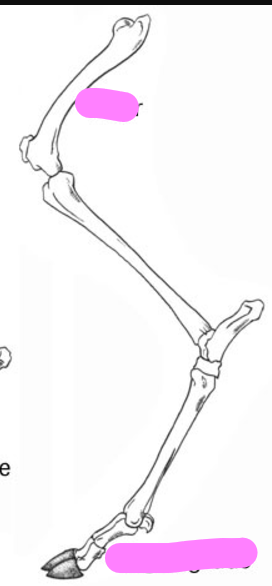
Digitgrade
Toe walking; Example: Dog
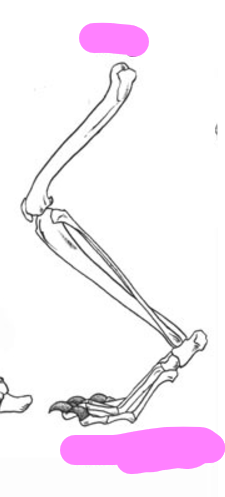
Plantigrade
Sole walking; Example: Human, rabbit

What makes the horse a fast runner?
much longer limbs
from wrist/hock down, NO muscle, only tendons + ligaments to provide elastic motion (snap forward)
large muscles housed higher in horse
limited transverse movement (removal of ulna + fibula)
How is transverse movement limited in horses?
No ulna or fibula
How do differences in relative bone lengths affect speed and power?
Greater ground contact relative to size (plantigrade) = more POWER
Smaller ground contact relative to size (unguligrade) = more SPEED
How many cervical vertebrae?
7
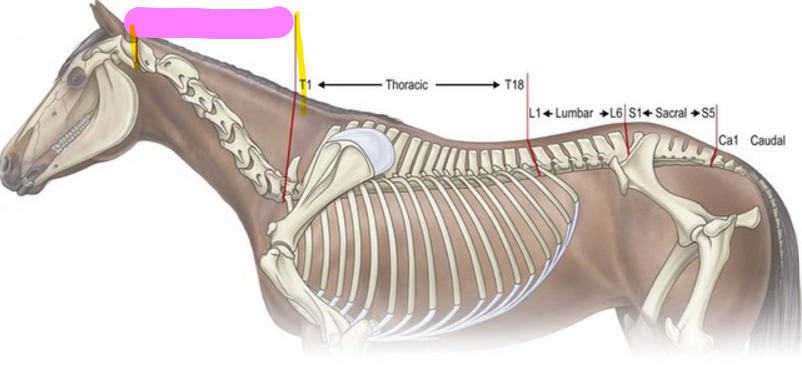
How many thoracic vertebrae?
18
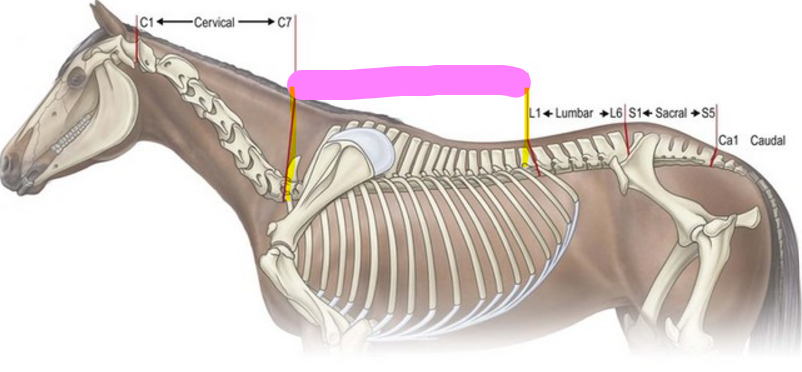
How many lumbar vertebrae?
6
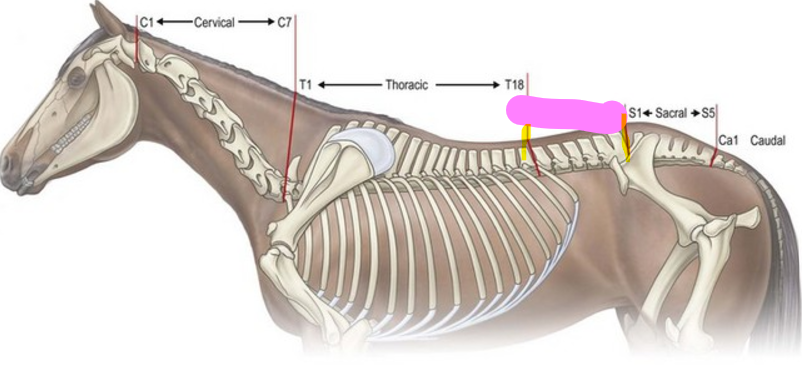
How many sacrum vertebrae?
5
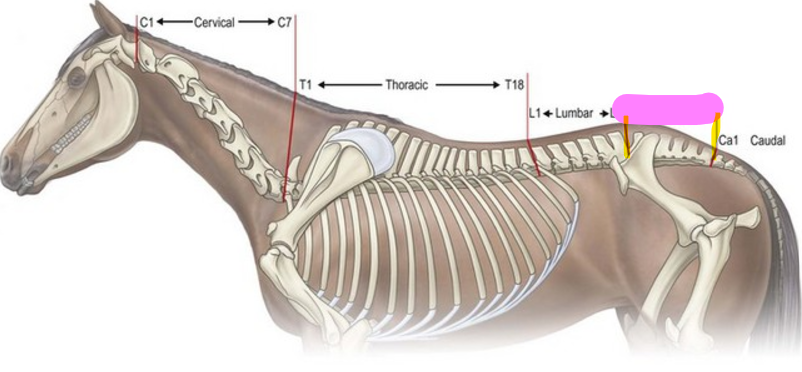
Cervical vertebrae characteristics
Larger vertebral arch, small dorsal and transverse spinous processes, larger articular processes
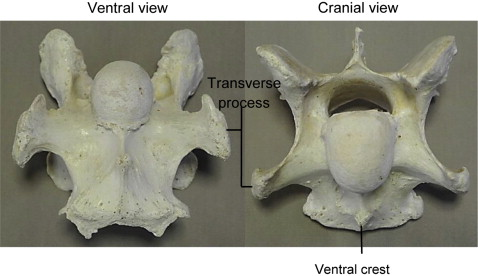
Thoracic vertebrae characteristics
Very tall dorsal spinous process, small transverse and articular spinous process
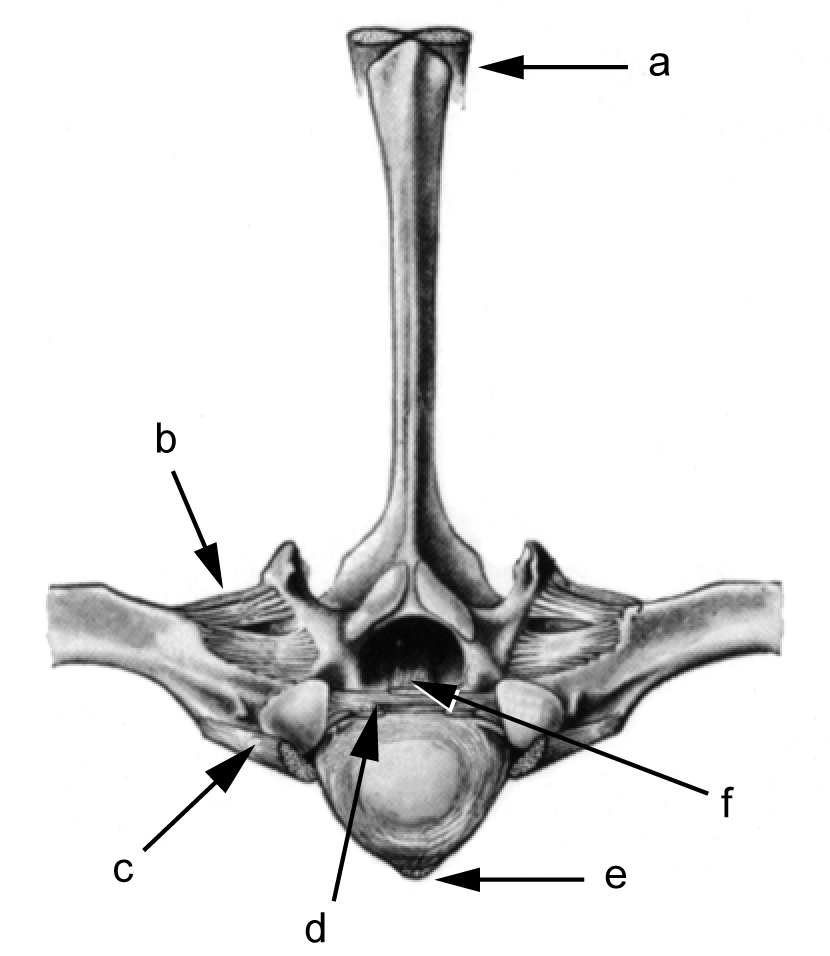
Lumbar vertebrae characteristics
Very long transverse spinous processes, midsized dorsal and articular spinous processes
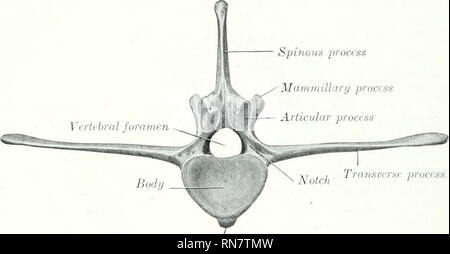
Function of Atlas
Joints with skull, nodding motion
Function of axis
rotation of head, has a raised dorsal spinous process in order to attach to Nuchal ligament
Purpose of Nuchal ligament
Energy conservation; holds onto heavy head as a “strap” while the horse is grazing as opposed to using muscles
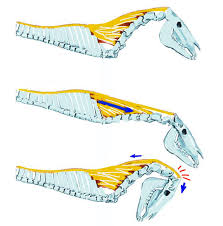
Most flexible portion of vertebrae
Cervical, chain allows movement of head + neck, “S” shaped
Articular surface for ribs (attachment points)
Thoracic vertebrae; capitulum (head) and tuberculum of rib
How many ribs?
18
How are the thoracic vertebrae oriented?
First 15 point backwards, middle straighteWhy ns out, last two incline forward
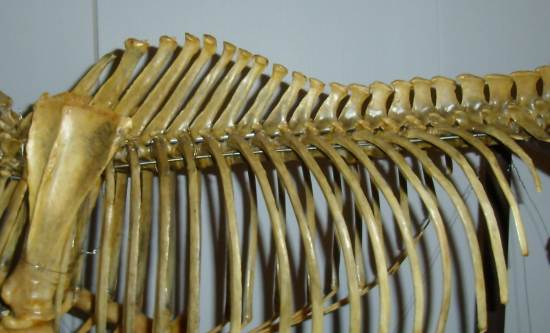
Why do horses have flat backs?
Grazing animals, GI track is HEAVY w/ a large volume; rigid spine stabilizes
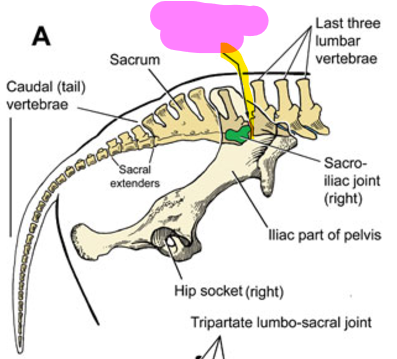
Lumbar + sacrum; allows for hindlegs to move together
Lumbosacral joint
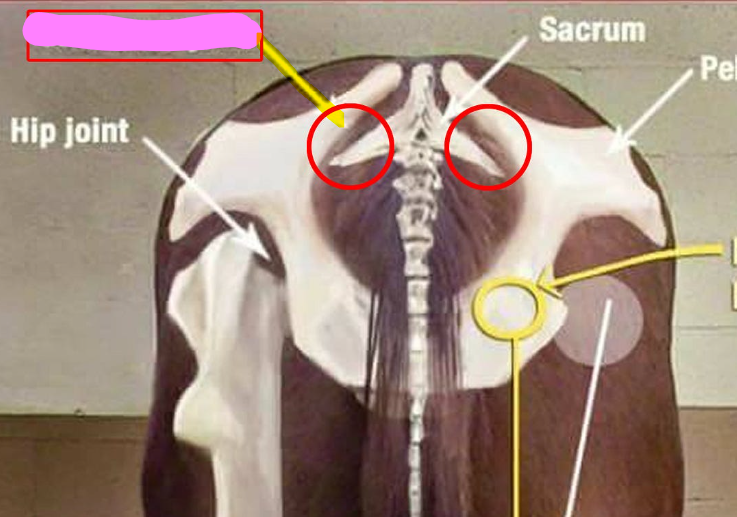
Spine + pelvis; allows for hindlegs to move individually and link hindquarters with rest of body; series of small synovial joints rather than 1 large joint
Sacroiliac joint
What types of horses are horses are more predisposed to sacroiliac arthritis?
Standardbred horses; trotters, shear SI joint
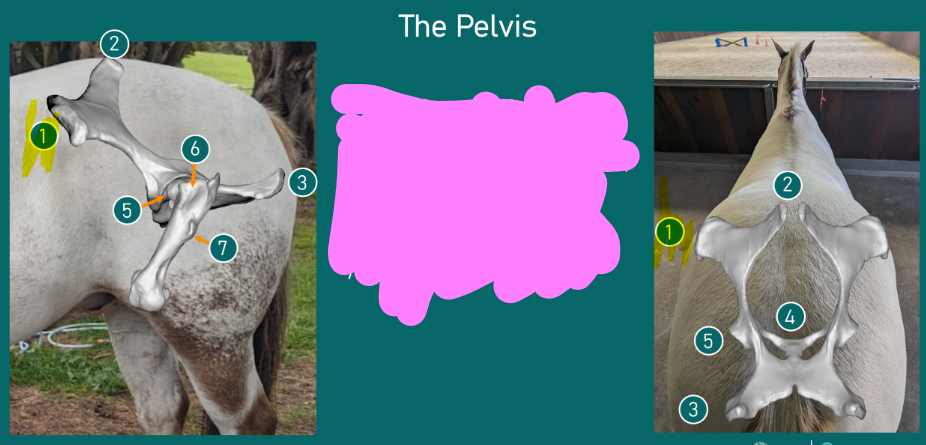
most lateral part of pelvis
Tuber coxae
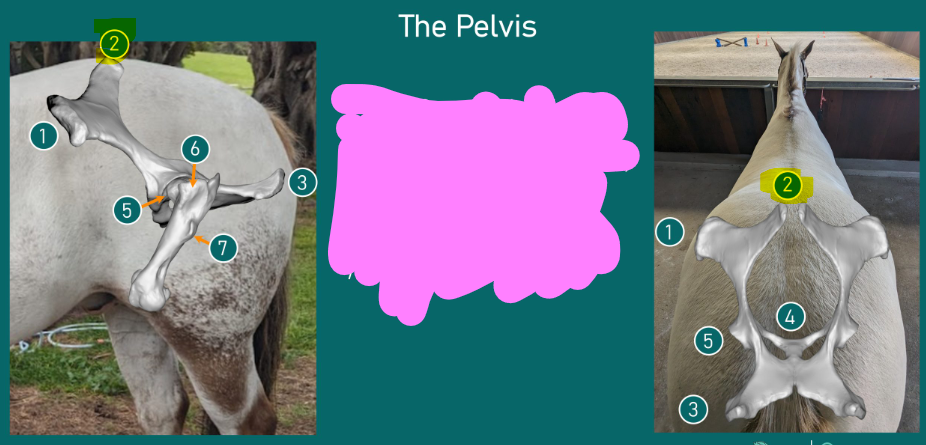
“hunter bump”, over sacrum
Tuber Sacrale
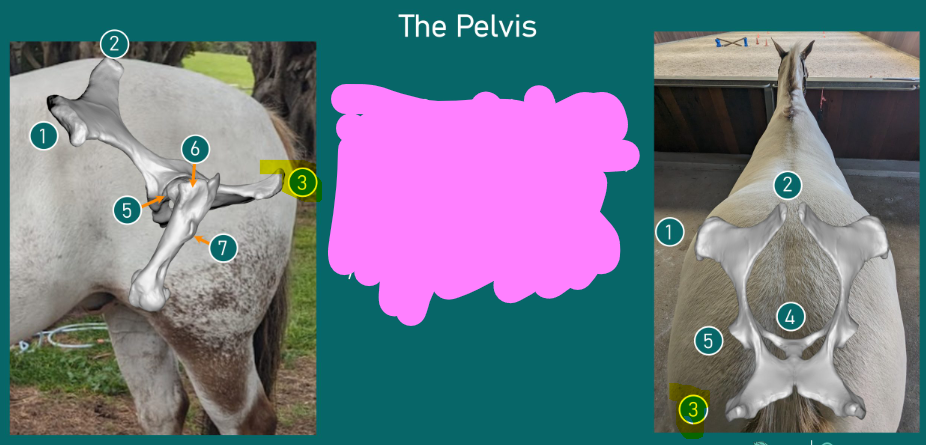
Seat bone
Ischium (Tuber Ischii)
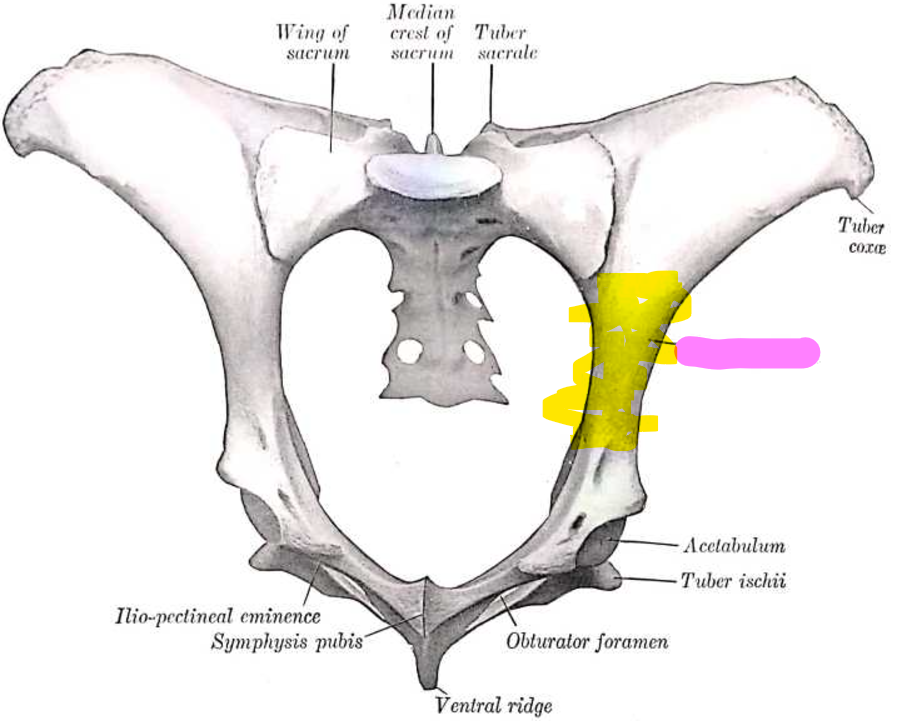
Ilium
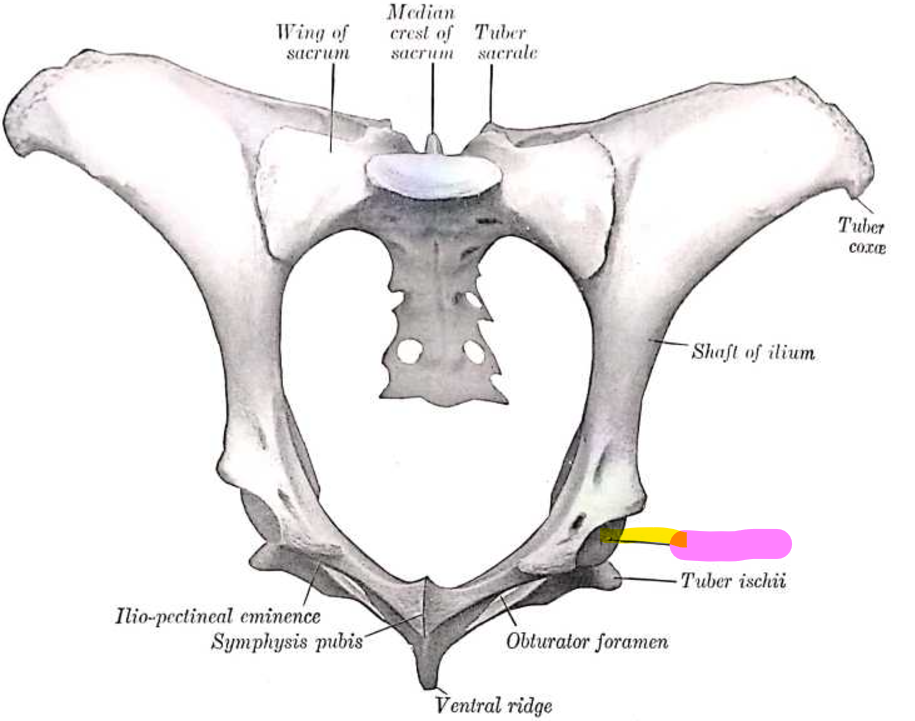
Connects to femur, hip socket
Acetabulum
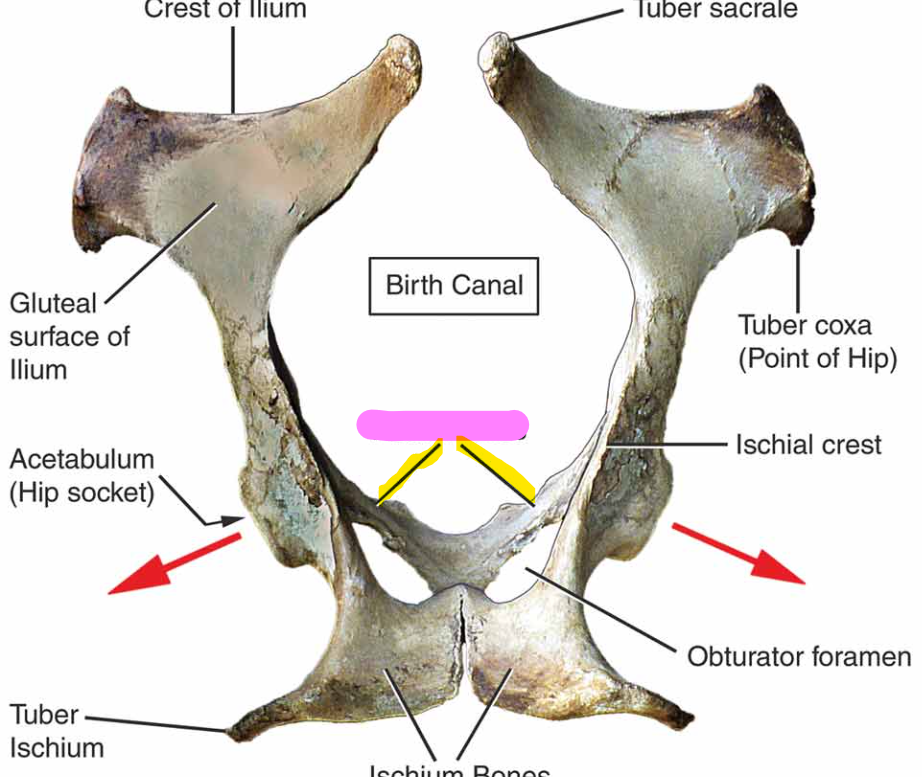
Pubis
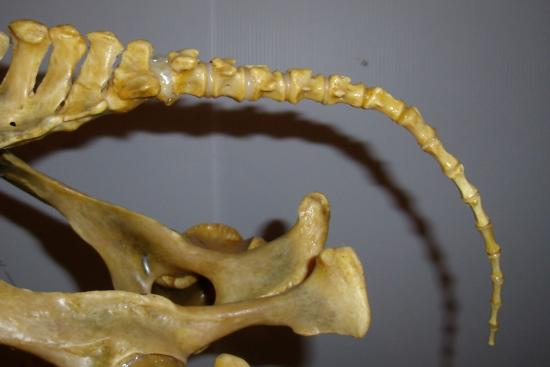
~18 tail bones
Coccygeal Vertebrae
Difference in front vs hind articulation with spine
Hind: Sacroiliac joint
Front: NO joint
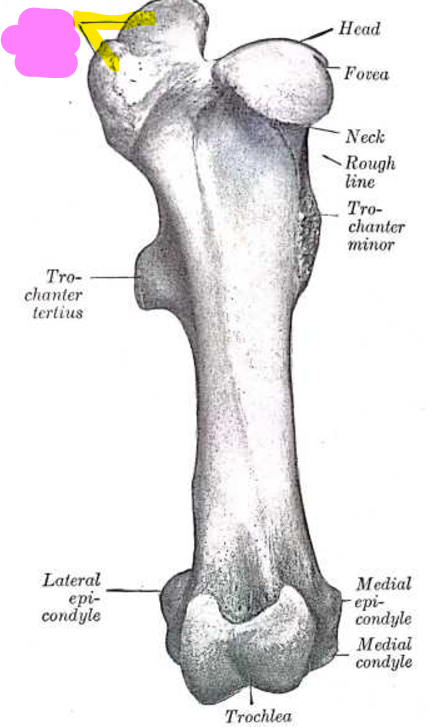
Site of glutes attachment
Major trochanter of femur
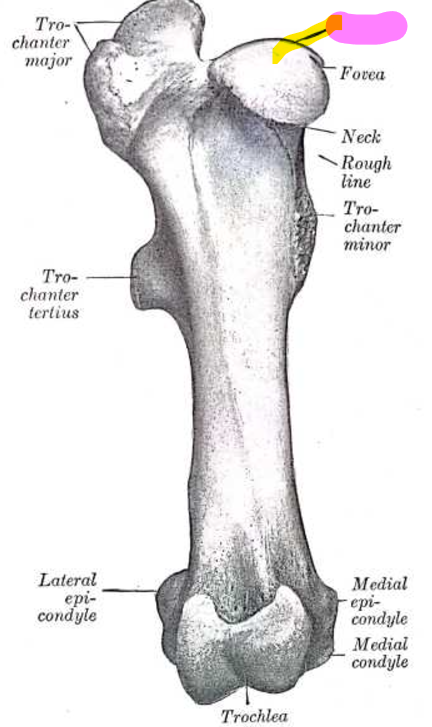
Connects w/ acetabulum
Head of femur
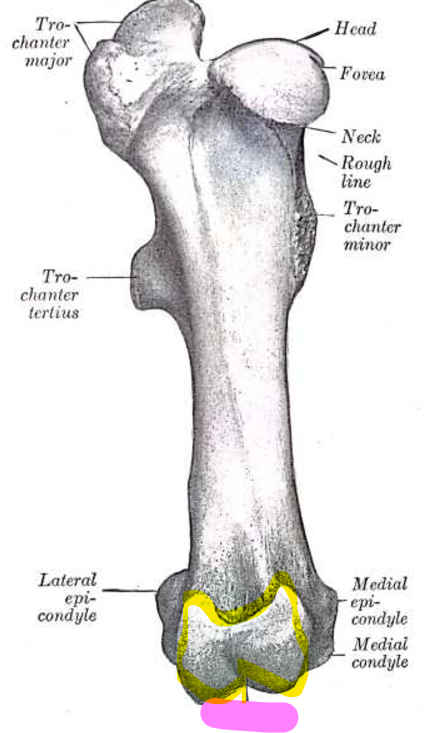
Uses patellar ligament to lock stifle
Trochlea of femur

Articulate w/ next bone (tibia)
Condyle of femur

Epicondyle of femur
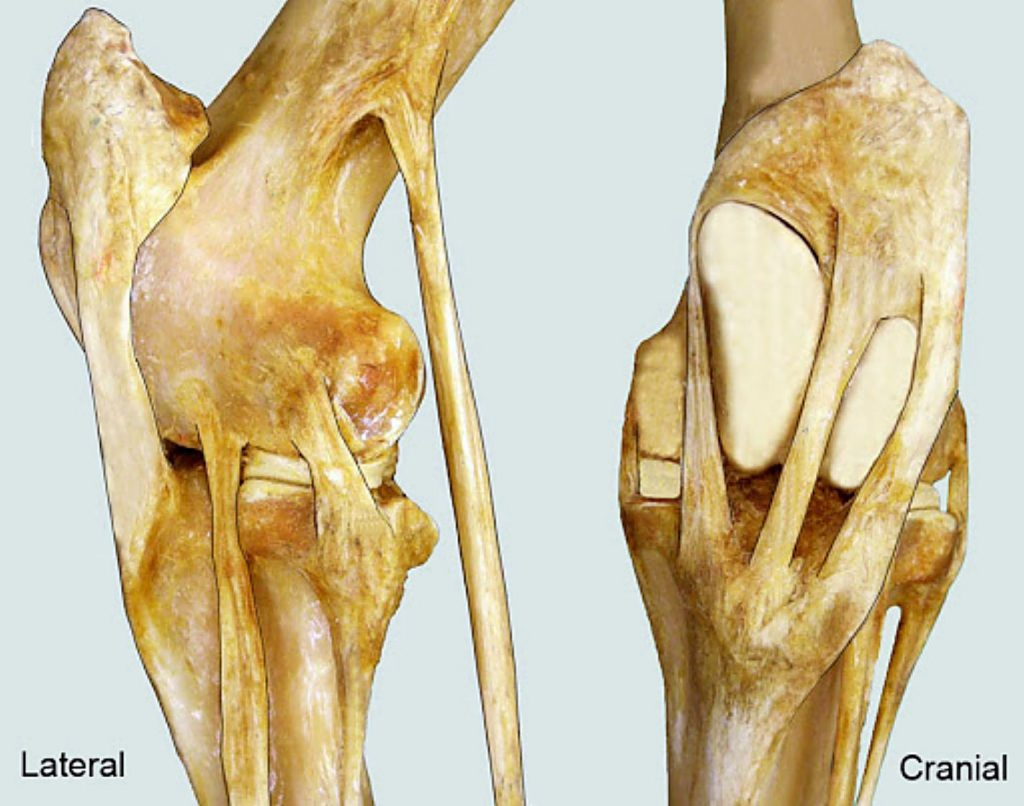
Joins femur + tibia
Stifle joint
What locks the stifle?
Patellar ligaments
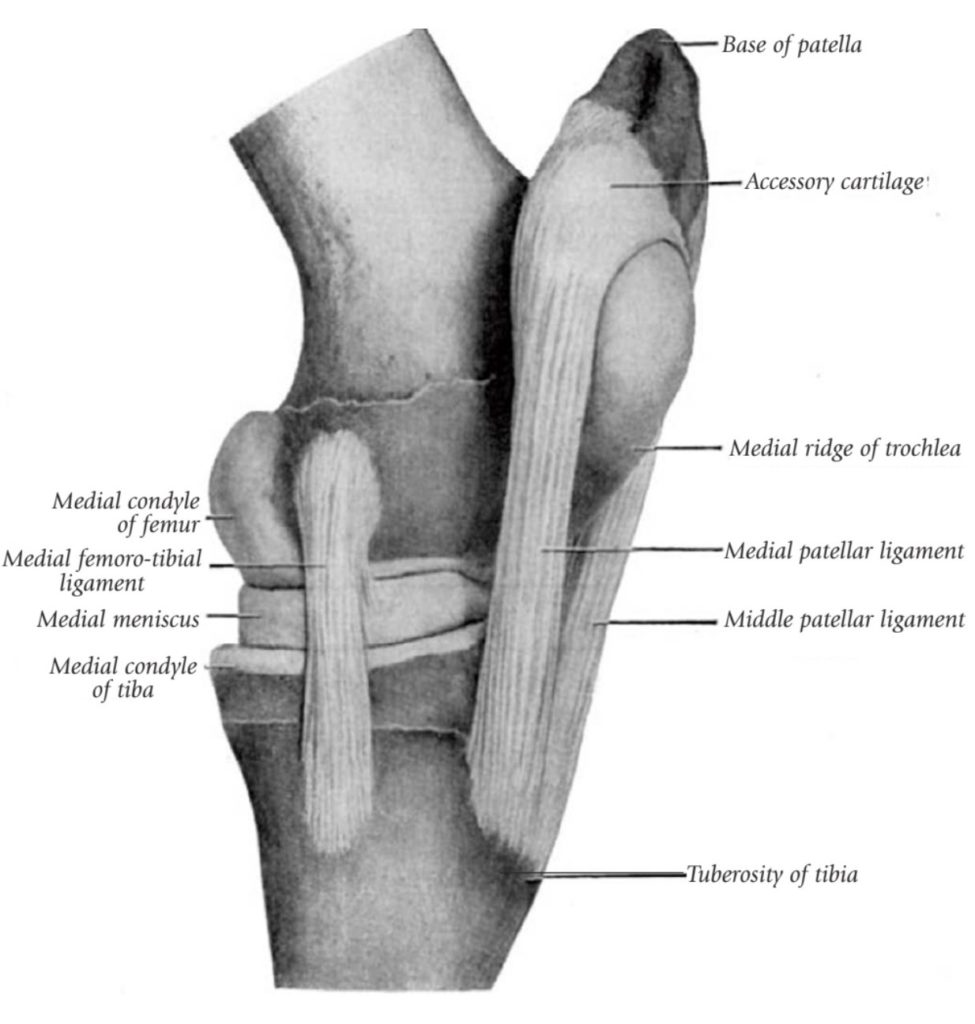
Why does the horse lock its stifle?
To conserve energy
What moves the patella to lock and unlock the stifle?
Quadriceps pull patellar ligaments up and around trochlea

Meniscus
What causes locking stifles?
Poor confirmation or weak musculature around stifle (specifically quadriceps)
Protracting muscles of hind quarters
Psoas, tensor facia latae, quadriceps (vastus muscles), peroneus tertius
Retracting muscles of hind quarters
Gluteal muscles, hamstrings (biceps femoris, semitendinosus, semimembranosus), gastrocnemius
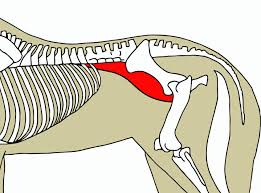
Protracting, attaches to pelvis + femur
Psoas